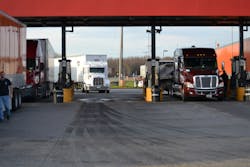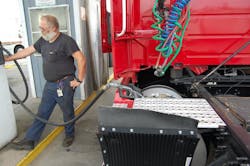The national average retail price for both diesel and gasoline continued to climb this week, according to data tracked by the Energy Information Administration (EIA), with prices for both fuels increasing in all regions of the country.
However, the agency’s data also shows that fuel prices remain well below those posted during the same week in 2015.
The national average retail price for diesel jumped up 3.3 cents this week to $2.198 per gallon, EIA reported, though that is 61.3 cents cheaper per gallon compared to the same week in 2015.
Diesel prices increased in every region of the country, the agency noted, with the largest one-week hike occurring in the Midwest, where prices increased 4.4 cents to $2.156 per gallon.
Not surprisingly, California claimed the highest average price for diesel in U.S. this week at $2.505 per gallon – which is 3.9 cents per gallon higher compared to last week – while the Gulf Coast remains home to the cheapest diesel at $2.074 per gallon, an increase of 2.8 cents from last week.
The national average retail price for gasoline jumped 2.5 cents this week to $2.162 per gallon, EIA noted, though that is 40.8 cents per gallon cheaper compared to the same week in 2015.
EIA also issued a report regarding state-level taxes and fees, noting that they averaged 26.5 cents per gallon as of January 1 this year: ranging from a low of 8.95 cents per gallon in Alaska to a high of 51.4 cents per gallon in Pennsylvania, in addition to the federal tax of 18.4¢/gal.
State taxes on diesel are slightly higher—averaging 27.4 cents per gallon, and ranging from 8.95 cents per gallon in Alaska to 65.1 cents per gallon in Pennsylvania—and are in addition to the 24.4 cents per gallon federal tax.
The agency added that many states allow localities or municipalities to impose additional taxes on motor fuels, with such “local option taxes” either applying broadly across all local jurisdictions, as in Florida and Hawaii, or more selectively, as in Mississippi where the state imposes a seawall tax on gasoline in just three counties that border the Gulf of Mexico.
Some municipalities, such as Chicago, also impose taxes in addition to state and local taxes. Although many local option taxes are cents-per-gallon taxes, some are percentages of the purchase price.
In California, most local jurisdictions have district sales and use taxes ranging from 0.10% to 2% in addition to the 2.25% state sales tax on gasoline and the 9.25% state sales tax on diesel fuel.
Yet EIA noted that revenue from motor fuel taxes is declining due to increased vehicle fuel economy, which is slowing the growth in gasoline and diesel consumption. Further, most states rely upon fixed per-gallon taxes that are not adjusted for inflation, the agency said.
As a result, many states now index all or a portion of their motor fuel excise taxes to inflation rates, EIA added, with Georgia recently passing legislation to index the state-level excise tax based on corporate average fuel economy standards and the U.S. consumer price index.
Other states index sales taxes that apply to motor fuels and also allow indexing at the local-government level, the agency pointed out.
About the Author
Sean Kilcarr
Editor in Chief
Sean Kilcarr is a former longtime FleetOwner senior editor who wrote for the publication from 2000 to 2018. He served as editor-in-chief from 2017 to 2018.


